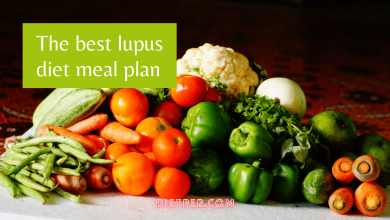
BRAT DIET: A healthy digestive system is essential for overall well-being. However, when digestive issues arise, they can cause discomfort and disrupt daily life. This is where the BRAT diet comes in. The BRAT diet is a time-tested dietary approach to help soothe the gut and alleviate digestive issues. It stands for Bananas, Rice, Applesauce, and Toast, and it’s a low-fiber, easy-to-digest diet recommended for people experiencing digestive issues like diarrhea, vomiting, or stomach flu.
What is the BRAT diet?
The BRAT diet, often recommended by healthcare professionals, is a simple and practical approach to help alleviate digestive issues. BRAT stands for Bananas, Rice, Applesauce, and Toast – four gentle and easily digestible foods that can relieve gastrointestinal distress.

This diet is commonly recommended for individuals experiencing gastrointestinal problems such as diarrhea, nausea, and stomach upset. The BRAT foods are selected for their binding properties, low fiber content, and ability to soothe the digestive system.
While the BRAT diet effectively provides temporary relief from digestive problems, it is essential to note that it is not nutritionally balanced for long-term use. It is best to follow this diet for a short period and gradually reintroduce a wider variety of foods as your digestive system improves.
Most Recommend Diet
- Tinea Versicolor Diet : The Guide for Clearer Skin
- How Roger Raglin Diet Plan Help Weight loss 2023 ?
- The 2468 diet: How to eat like a millionaire ?
Brat diet Food list
The BRAT diet is a well-known approach to help ease digestive discomfort and recover from an upset stomach. The acronym BRAT stands for Bananas, Rice, Applesauce, and Toast, which are the staple foods recommended during this recovery period. Let’s take a closer look at the BRAT diet food list and understand why these foods are recommended.
1. Bananas

Bananas are a fantastic choice for a gentle and easy-to-digest food. They are rich in potassium, which helps restore electrolyte balance and prevent dehydration. The soft texture of bananas is soothing to the stomach and can help alleviate nausea.
2. Rice

Plain white rice is an excellent source of digestible carbohydrates. It helps bind loose stools and provides a mild source of energy. Opt for plain boiled rice without any additional spices or flavors.
3. Applesauce

Unsweetened applesauce is another component of the BRAT diet that is gentle on the stomach. It is low in fiber and easy to digest, making it an ideal choice for individuals experiencing digestive distress. Make sure to choose unsweetened varieties to avoid added sugars.
4. Toast

Plain toast, made with white bread, is a bland and digestible source of carbohydrates. Toast can help settle an upset stomach and provide some relief from nausea.
The core BRAT foods and other recommended options during recovery include boiled potatoes, boiled chicken without skin, clear fluids like broth or electrolyte drinks, and herbal teas (such as chamomile or peppermint) to soothe the digestive system.
Benefits of brat diet
Many people turn to the BRAT diet as a tried and tested method to ease digestive discomfort. The acronym BRAT stands for Bananas, Rice, Applesauce, and Toast, which are the primary components of this diet. This section will explore the benefits of the BRAT diet and why it is often recommended when one’s stomach feels off.
5 Benefits Of BRAT Diet
1. Easy to Digest
One of the main benefits of the BRAT diet is that it consists of bland and easily digestible foods. Bananas, rice, applesauce, and toast are all gentle on the stomach, making it easier for your body to break them down and absorb the necessary nutrients. This can relieve nausea, vomiting, and diarrhea, allowing your stomach to settle.
2. Restoring Electrolyte Balance
When you’re experiencing an upset stomach, your body can lose essential electrolytes through vomiting or diarrhea. The BRAT diet includes bananas, rich in potassium, an important electrolyte. Consuming bananas can help restore electrolyte balance, preventing dehydration and supporting overall recovery.
3. Binding Effect
Rice and toast, both prominent components of the BRAT diet, bind the stool. This means they can help firm up loose bowel movements by absorbing excess water in the digestive system. This can be particularly helpful in cases of diarrhea, providing relief and promoting a faster recovery.
4. Mild and Nourishing
The BRAT diet is gentle on the stomach and provides essential nutrients and energy during digestive distress. Bananas offer potassium and carbohydrates, while rice provides carbohydrates and some protein. Applesauce offers a source of fiber and vitamin C, and toast provides carbohydrates for energy. Consuming these foods can nourish your body without overloading your sensitive stomach.
5. Gradual Transition
Another advantage of the BRAT diet is its ability to serve as a transitional phase towards normal eating. After a bout of stomach upset, reintroducing regular foods can be challenging. The BRAT diet bridges between a limited diet and the resumption of a standard, balanced meal plan. Following your body’s cues, you can gradually introduce other foods once your stomach feels better.
Is the BRAT diet safe?
The BRAT diet is generally considered safe and gentle on the stomach, making it a popular choice for easing digestive discomfort in adults and children. Its simplicity and blandness make it easy to digest and less likely to aggravate an already sensitive stomach.
However, it is important to note that the BRAT diet is not nutritionally complete and lacks certain essential nutrients, such as protein and healthy fats. Therefore, following this diet for an extended period is not recommended, especially for individuals with existing health conditions or those with specific dietary needs.
While the BRAT diet can provide temporary relief, it is crucial to gradually reintroduce a varied and balanced diet to ensure adequate nutrition and promote overall health. This includes incorporating foods from different food groups, such as lean proteins, fruits, vegetables, and whole grains, once your stomach feels better.
The BRAT diet can be a safe and effective short-term strategy for individuals with upset stomachs, but it should not be followed for an extended period. A well-rounded diet is essential for overall health and should be reintroduced gradually once symptoms improve.
Foods To Avoid
When recovering from an upset stomach, the BRAT diet is often recommended as a gentle way to ease digestion and provide relief. However, it’s just as important to know what foods to avoid during the BRAT diet to ensure a speedy recovery.
1. First, it is crucial to stay away from fatty and greasy foods. These can be hard for the stomach to digest and may aggravate your upset stomach further.
- Foods such as fried chicken, French fries, and greasy burgers should be strictly avoided during this time.
- Spicy and heavily seasoned foods should also be kept off your plate. They can irritate your digestive system and potentially worsen your symptoms.
- Foods like hot peppers, spicy sauces, and heavily seasoned curries should be off-limits while following the BRAT diet.
2. Secondly, it is best to steer clear of dairy products during this time. Lactose, the sugar found in milk and other dairy products, can be complex for your stomach to break down if upset.
- -Avoid consuming milk, cheese, yogurt, and ice cream until your stomach fully recovers.
3. Lastly, avoiding high-fiber foods or foods that are difficult to digest is essential. This includes whole grains, nuts, seeds, raw vegetables, and fruits with tough skins. These foods can increase the workload on your digestive system and prolong your recovery.
How does it work?
The BRAT diet, consisting of bananas, rice, applesauce, and toast, has long been recommended as a go-to remedy for digestive issues such as upset stomach, diarrhea, and vomiting. But how does this simple combination of foods work?
The BRAT diet is based on providing easily digestible foods that are low in fiber and fat. These foods are gentle on the stomach and help to soothe and firm up the stool. Let’s take a closer look at the four components of the BRAT diet and how they contribute to its effectiveness.
The four components of the BRAT diet
- Bananas
Bananas are rich in potassium, an essential mineral that helps maintain electrolyte balance in the body. They are easy to digest and provide a good source of energy. Bananas also contain pectin, a soluble fiber that can help absorb excess water in the digestive system and firm up loose stools.
- Rice
Plain white rice is a bland, starchy food that is easy on the stomach and provides energy. It helps to bind the stool and reduce the frequency and severity of diarrhea. Rice also acts as a bulking agent, adding substance to the chair and promoting more regular bowel movements.
- Applesauce
Applesauce is another easily digestible food that provides a source of vitamins and minerals. It is gentle on the stomach and can help alleviate symptoms of nausea and vomiting. Applesauce also contains pectin, which has a soothing effect on the digestive system.
- Toast
Toast Plain, dry toast is a low-fiber food that is gentle on the stomach and easy to digest. It provides carbohydrates for energy without putting additional strain on the digestive system. Toast can help absorb excess stomach acid and relieve nausea and vomiting.
Together, these four components work synergistically to provide a balanced and gentle diet for individuals experiencing digestive issues. The BRAT diet helps to calm the stomach, firm up loose stools, and alleviate symptoms such as nausea and vomiting.
It is important to note that the BRAT diet should only be followed for a short period, typically 24-48 hours, to allow the digestive system to recover. It is not nutritionally complete and lacks essential nutrients such as protein and fat. Therefore, it is advisable to reintroduce a varied and balanced diet as symptoms improve gradually.
Brat diet For upset stomach
Brat diet For upset stomach When it comes to an upset stomach, finding relief is a top priority. The BRAT diet is easy to follow and gentle on your stomach.

The BRAT diet helps to reduce the strain on your digestive system, giving it a chance to recover and heal. It is important to note that the BRAT diet is not intended to be a long-term solution but rather a temporary measure to help calm your upset stomach. While following the BRAT diet, staying hydrated by sipping clear liquids such as water, ginger ale, or herbal teas is essential.
Toast in brat diet
Regarding the BRAT diet, toast is a go-to option to help soothe an upset stomach and provide easily digestible carbohydrates. Toast is a simple and bland food that is gentle on the digestive system, making it an ideal choice for those experiencing digestive discomfort or recovering from illness.
Toast, in particular, offers additional benefits to the BRAT diet. It provides a comforting and familiar texture, which can help ease discomfort. Additionally, the carbohydrates in toast give a quick energy source without putting stress on the digestive system.
When incorporating toast into the BRAT diet, opting for plain, white bread without any added ingredients or toppings that could potentially aggravate the stomach is important. Toast can be lightly toasted to maintain its soft texture and should be consumed in small, frequent portions throughout the day.
Alternatives of brat diet
While the BRAT diet has long been recommended for individuals with gastrointestinal issues, there are alternatives worth exploring. These alternatives provide a more comprehensive range of nutrients and can be just as effective in aiding recovery from stomach upset or digestive problems. Here are a few other options to consider:
1. The MASH diet
Similar to the BRAT diet, the MASH diet includes gentle foods on the stomach. MASH stands for Mashed bananas, Applesauce, Sweet potatoes, and Herbal tea. These foods are easy to digest and provide essential nutrients like potassium, fiber, and vitamins.
2. The GAPS diet
The Gut and Psychology Syndrome (GAPS) diet focuses on healing the gut and improving digestion. It incorporates easily digestible foods like homemade broths, fermented vegetables, cooked fruits, and well-cooked vegetables. This diet aims to restore gut health and promote overall well-being.
3. The SCD diet
The Specific Carbohydrate Diet (SCD) eliminates complex carbohydrates and focuses on simple, easily digestible foods. It includes lean meats, eggs, non-starchy vegetables, and certain fruits. This diet aims to reduce inflammation and promote healing in the digestive system.
4. The FODMAP diet
The FODMAP diet is designed to help individuals with irritable bowel syndrome (IBS) manage their symptoms. It involves avoiding certain carbohydrates that can trigger digestive issues, such as lactose, fructose, and certain fibers. This diet focuses on low-FODMAP foods like rice, quinoa, lean meats, and certain fruits and vegetables.
Before trying any of these alternatives, it is important to consult with a healthcare professional or a registered dietitian. They can provide personalized guidance based on your specific needs and health condition. Everyone’s digestive system is unique, so finding the proper diet that works for you may involve trial and error.
Brat diet For vomiting
The BRAT diet is a popular dietary approach for individuals recovering from an upset stomach and experiencing vomiting. Our digestive system becomes sensitive and easily irritated when unwell, especially with a stomach bug.
The BRAT diet is designed to be easy on the stomach, providing bland and easily digestible foods that can help soothe the digestive system and prevent further discomfort.
By following the BRAT diet, individuals can give their stomach the rest it needs to recover while providing essential nutrients. It is important to note that the BRAT diet is not meant to be a long-term solution but rather a short-term approach to ease symptoms and gradually reintroduce a wider range of foods as the stomach heals.
Brat diet For diarrhea
Alongside the BRAT diet, make sure to drink plenty of fluids, such as water or clear broth, to replace the fluids lost during episodes of diarrhea. The BRAT diet is a popular and trusted approach to managing diarrhea, providing a gentle and easily digestible way to ease symptoms and aid in recovery. However, it should not be followed for an extended period, as it may lack essential nutrients for overall health.
Brat diet For adults
The BRAT diet, often recommended for adults experiencing an upset stomach, is a simple and effective way to alleviate digestive discomfort. The acronym stands for Bananas, Rice, Applesauce, and Toast – four bland and easy-to-digest foods that can help soothe an upset stomach and promote recovery.
21-day brat diet food list
If you are planning to follow the BRAT diet for 21 days, here is a comprehensive food list to help you plan your meals and ensure you are getting the proper nutrition:
- 1. Bananas: Rich in potassium, easily digestible, and gentle on the stomach.
- 2. Rice: Opt for plain white rice, which is easy to digest and provides carbohydrates for energy.
- 3. Applesauce: Unsweetened and smooth applesauce can be a great source of fiber and vitamins.
- 4. Toast: Choose plain, white toast that is low in fiber to avoid further irritation to the digestive system.
- 5. Chicken: Cooked, skinless chicken provides lean protein and is easy to digest.
- 6. Fish: Opt for low-fat varieties such as cod or sole, which are gentle on the stomach.
- 7. Cooked vegetables: Steamed or boiled carrots, green beans, and zucchini are more accessible to digest than raw vegetables.
- 8. Clear broth: Sip on clear vegetable or chicken broth to stay hydrated and replenish essential electrolytes.
- 9. Yogurt: Choose plain yogurt with live cultures to promote healthy gut bacteria.
- 10. Oatmeal: Made with water or low-fat milk, oatmeal is a gentle source of fiber and provides sustained energy.
Remember to avoid spicy, fatty, and high-fiber foods during the 21-day BRAT diet.
How to incorporate the BRAT diet into your daily routine?
Incorporating the BRAT diet into your daily routine is a simple and effective way to promote digestive health. Whether recovering from a stomach bug or experiencing digestive issues, following this diet can help soothe your stomach and provide relief.
To begin, it’s essential to understand the BRAT diet. The acronym stands for bananas, rice, applesauce, and toast – all of which are gentle on the stomach and easy to digest. These foods are low in fiber, fat, and spices, making them ideal choices when your digestive system needs a break.
Start by incorporating bananas into your diet. They are nutritious and help restore electrolyte balance due to their high potassium content. You can enjoy a ripe banana as a snack or add slices to your morning cereal or yogurt.
Next, opt for plain white rice. Boiled rice is easy to digest and can be paired with lean protein and cooked vegetables for a balanced meal. If you’re feeling adventurous, cook rice porridge in extra water until it becomes soft and soupy.
Applesauce is another excellent addition to the BRAT diet. It provides essential vitamins and minerals while being gentle on the stomach. Choose unsweetened applesauce to avoid added sugars, and enjoy it as a snack or a side dish with your meals.
Lastly, include plain toast in your daily routine. Opt for whole wheat or gluten-free bread if you have dietary restrictions. Toasted bread provides a bland and soothing option that can be topped with a small amount of Butter or a sprinkle of cinnamon for added flavor.
Remember, the BRAT diet is not meant to be a long-term solution but a short-term approach to help calm your digestive system. It’s important to reintroduce various nutrient-rich foods once your stomach has settled gradually.
Consulting with a healthcare professional
It is always advisable to consult with a healthcare professional regarding digestive health matters. While the BRAT diet is generally considered safe and effective for relieving digestive issues, it is essential to remember that everyone is unique, and what works for one person may not work for another.
A healthcare professional, such as a doctor or a registered dietitian, can provide personalized advice based on your specific needs and medical history. They can assess your symptoms, diagnose any underlying conditions, and recommend appropriate dietary changes or modifications.
Frequently Asked Questions
Why is the brat diet no longer recommended?
The BRAT diet is no longer considered the best approach for managing bland and easily digestible foods that would help soothe the stomach and relieve gastrointestinal discomfort. One of the main concerns with the BRAT diet is its need for nutritional diversity. While it may provide temporary relief, the diet lacks essential nutrients, including protein, healthy fats, fiber, and vitamins.
Can you put Butter on toast for a brat diet?
No, Butter is a high-fat food, and fats can be more difficult for the body to break down, especially during digestive distress. If you strictly follow the BRAT diet, avoiding adding Butter to your toast is recommended.
How long to stay on a brat diet after diarrhea?
The BRAT diet is crucial to note that the BRAT diet is not meant to be followed for an extended period. The general recommendation is to follow the BRAT diet for 24 to 48 hours after the diarrhea has subsided. This allows your digestive system to regain strength and return to normal functioning.
When can I start the BRAT diet after vomiting?
The timing of when to start the BRAT diet after vomiting can vary depending on the individual and the severity of their stomach upset. It’s generally recommended to wait until the vomiting has stopped for at least a few hours before introducing the BRAT diet. This allows your stomach time to settle and reduces the risk of further irritation.
Is yogurt OK on the BRAT diet?
Yes, yogurt can be included in the BRAT diet. While it may not be one of the core components, yogurt can provide additional benefits to those experiencing gastrointestinal distress.
Disclaimer: The information provided is for educational purposes only and is not a substitute for professional medical advice. Always consult a dietician/healthcare professional before making any changes to your treatment plan.





You’re welcome! Thank you for your understanding. If you have any specific questions, topics, or areas of interest you’d like to explore, feel free to share them. Whether it’s about technology trends, scientific discoveries, literary analysis, or any other subject, I’m here to provide information and assistance. Just let me know how I can assist you further, and I’ll be happy to help!
Thank You So Much